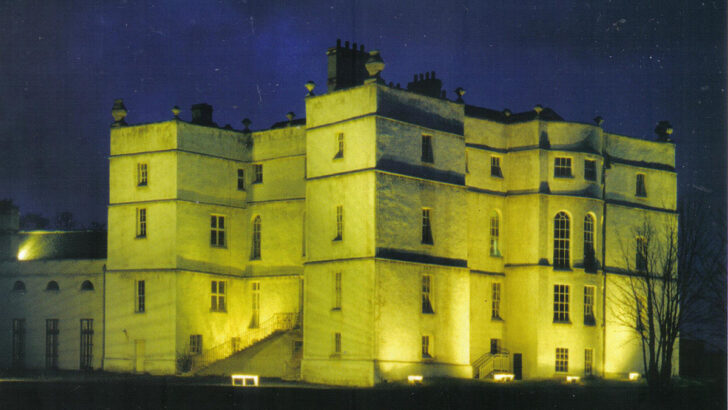Rathfarnham Castle Guidebook,
by Jane Fenlon and others
(OPW, €5.00)
There must be thousands of living Dubliners who have memories of Rathfarnham Castle as it was back in the last century under the auspices of the Jesuits, when it was a noted Jesuit seminary and retreat centre.
The Jesuits, who had taken over the estate in 1913, put it on the market in 1986. There was a local outcry that the ancient mansion might be swept away by development. The Castle was declared an Ancient Monument and passed into the care of the Office of Public Works. The extensive grounds were taken into the care of the South Dublin Council as a public park.
At the castle the Jesuits House of Studies and the retreat centre were demolished, and a programme to restore the castle to something like its former style was begun. This programme continues: restoration takes time. But what is to be seen is well worth a visit. The official guide book, aside from being most informative, is really good value at the price.
Presence
The Jesuit presence is not quite forgotten. Visitors interested in that period can ask at the reception desk where tickets are issued for an album of photos and recollections that recalls those days. Many familiar names, of which Blessed John Sullivan, who was rector there for a time, would be the best known.
Retreatants of old will not be surprised that prominent in the memories of others of that clan is the memory of the food served, which was a further penitential exercise for some.
The history of the castle is complicated. It seems that the site was originally fortified at the time of the Norman invasion, to help keep at bay those warlike clans in the mountain to the south.
After the Desmond rebellion in 1583 the lands were confiscated by the Crown, and passed into the ownership of Adam Loftus, who was the chaplain of the Lord Deputy, Lord Sussex, who was to become Anglican archbishop of Dublin and Chancellor in 1581.
In the saloon the original panels which originally showed the scenes from The Odyssey of Ulysses and Calypso; these were replaced by the Jesuits with a series on the life of Christ painted by Patrick Tuohy”
The castle we see today was erected in 1583. It is not an actual castle in the old medieval sense, but rather a fortified house. And as a house was fitted out in great luxury, the surviving remnants of which can be seen today in the public rooms. The castle changed hands in the Parliamentary wars.
However, in 1767 it was sold by one of the Loftus family to the notorious Speaker Connolly, but he rightly proffered his great house at Castletown. The Loftus family returned, and the house was once again an epitome of fine style. But it slowly decayed and was said to be abandoned by the end of the century. It then became the property of the Blackburne family who brought it up to date with such useful conveniences as bathrooms. The Blackburnes sold it to the Jesuits in 1913, and its more familiar period began.
Restoration
What visitors can see today though still in the process of restoration is of great interest. One enters through the basement where the kitchen and the servants quarters would have been, as well as the wine cellar. This is severely practical: on the day we visited, it housed a display of avant garde modern glass making.
Above this on the first floor are the entrance hall, the Saloon and the Dining room. A relic of the old fence system can be seen in the two towers where windows overlook the space between them for the convenience of gunners.
In the saloon the original panels which originally showed the scenes from The Odyssey of Ulysses and Calypso; these were replaced by the Jesuits with a series on the life of Christ painted by Patrick Tuohy. These must now be the most extensive display of his art in Ireland, and have in themselves become an important element in the present day decor.
On the second floor the most important room in the castle, the Gallery / Ballroom, which the Jesuits had used as a chapel was closed for the day on our visit, but this represents the peak of the decoration.
There are lessons here for everyone. For the history of the place is something of an epitome of the changing nature of Irish society since the days of Elizabeth I. Great care is going into the full realisation of the restoration in another decade or so.
Yet there will be many visitors – among many who came here once to use the library that the Jesuits had here, and to take part in retreats. Back in 1913 it was full of ongoing enterprise for the Catholic religion; now all that has vanished.
On the afternoon of our visit the grounds were being used by families and dog walkers, and by parties practising Tai Chi and Oriental martial arts.
Former retreatants will find it a strange experience revisiting what was once a place of spiritual renewal. There is somewhere here a parable seeking to make itself understood.
Seasonal opening times: May – September – Open daily – 9:30 – 17:30; October – April – Wednesday to Sunday and Bank Holiday Mon – 10:30 – 17:00.
Guided tours available. Group tours must be booked in advance by calling 01 493 9462 or emailing rathfarnhamcastle@opw.ie. Admission charges: Adult: €5.00; Senior/Group: €4.00; Child/Student: €3.00; Family: €13.00.


 Peter Costello
Peter Costello The almost ghostly presence of Rathfarnham Castle at night, haunted by its past (photo courtesy of the OPW)
The almost ghostly presence of Rathfarnham Castle at night, haunted by its past (photo courtesy of the OPW) 